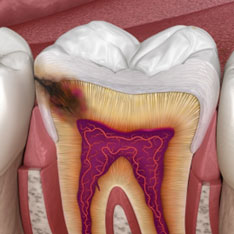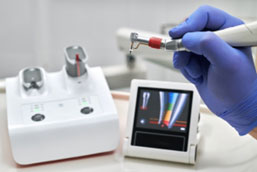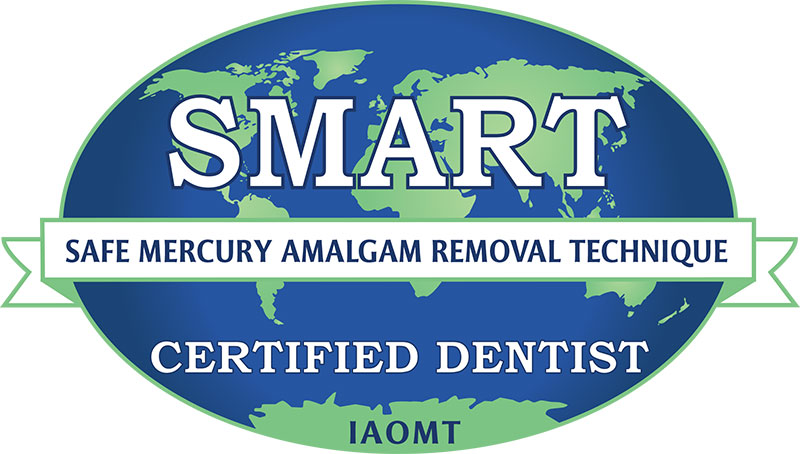What is root canal treatment?
The progress of dental caries through the enamel, dentin and dental pulp system.
Teeth have an outer hard shell (enamel) covering the softer core substance (dentine).
Inside the tooth (pulp) are living tissues, including cells, collagen fibres, productive cells, immune cells and aground substance, which are innervated and supplied with blood vessels via the end root nerve/blood bundles.
As a result of intensive and chronic long-term bacterial chemical, mechanical, and thermal trauma, the immune system within the pulp causes irreversible hyper-inflammatory reaction whilst the compromised regenerative capacity of the pulp within this closed chamber creates pressure on the pain receptors along the periphery of the pulp chamber.

Triggering of the pain receptors conducts the unpleasant sensitivity, pain or toothache via the nerve fibres passing through the apex of the tooth root. The root canal pulp tissue inflammation is caused by a prolonged bacterial irritation normally caused by extensive and deep tooth decay or a leaking filling.
A thorough clinical inflammation or X-ray in combination may determine the presence and location of tooth decay, tooth damage, defective filling, or infection around the tooth root.
Root canal treatment is required when the inflammatory damage to the pulp tissue is irreversible. Therefore, the damaged or infected tissues within the tooth chamber should be removed. The chamber’s walls should be cleansed by chemical and mechanical means to disinfect the remnant of bacterial residues.

A rotary instrument with a digital measurement

Magnifying device to explore the canals
How is root canal treatment being done?
Depending on the complexity of the root canal system and the extent of infection, root canal treatment may require a few treatment visits. Local anaesthesia is administered for painless removal of the inflamed and infected tissues inside the root canals. Both rotary and hand instruments are used to efficiently eliminate the residual pulp tissue remnants. Various techniques are used for cleaning and shaping the root canals, which involve the use of fine instruments called files. To prevent the recurrence of the infection, the root canal space is tightly sealed with obliterating materials. During the last session, the root canal-treated tooth will be provided with an appropriate restoration to adequately support and protect the remaining tooth substance.
What could happen after a tooth is root canal treated?
The mild tenderness or soreness around the tooth root following root treatment may settle within a few days. The pain could be soothed with in-the-counter painkillers. Although most root canal treatments are successful, some factors could compromise the quality of the treatment’s clinical outcome despite the best techniques being employed. Therefore, the quality of the root canal system can’t always be guaranteed, particularly in teeth with complex root anatomy.
What other treatment may be required?
As a result of root canal preparation and removal of the tooth substance to access the root canal system, especially in the crown area, the strength of the remaining tooth structure is reduced, and the tooth is weakened. The restorative dentist should, therefore, reinforce the tooth using adhesive fibre posts and core to secure the definitive filling or crown required to protect the tooth. Some root-treated teeth may look darker than the adjacent teeth. Your dentist will discuss alternative cosmetic treatments to improve the tooth’s appearance when necessary.
FAQ – What do patients usually ask about endodontics and rootcanal treatment?
Statistically, ca. 9 out of 10 root-treated teeth will have an 8-10-year survival rate. In rare cases, when the root canal treatment does not result in a symptom-free tooth, the dentist should discuss about the causes for the possible increased risk of the treatment failure and why the tooth may have a poor prognosis.
In rare cases when the root infection remains despite a high standard of root canal treatment, a localised operation is required to remove the tip of the root (apicectomy) and seal the tip of the root.
In cases when the tooth is not amenable to any remedial treatment, you will be informed about the ultimate need for tooth extraction and replacement with alternative restorative options.
The survival rate of the tooth is determined by several factors, including:
- The extent the remaining natural tooth structure.
- The functional mechanical forces on the tooth during mastication.
- Adequate oral hygiene practice prolongs the life span of all teeth in general.
- Care should be taken not to bite on the hard foods before your treatment is completed.
- Some over-the-counter painkillers could relieve the pain and discomfort.
- Return to your dentist if you still have pain or swelling after using painkillers.
Root Canal Case Studies
See our root canal before and after photos from our happy patients.

